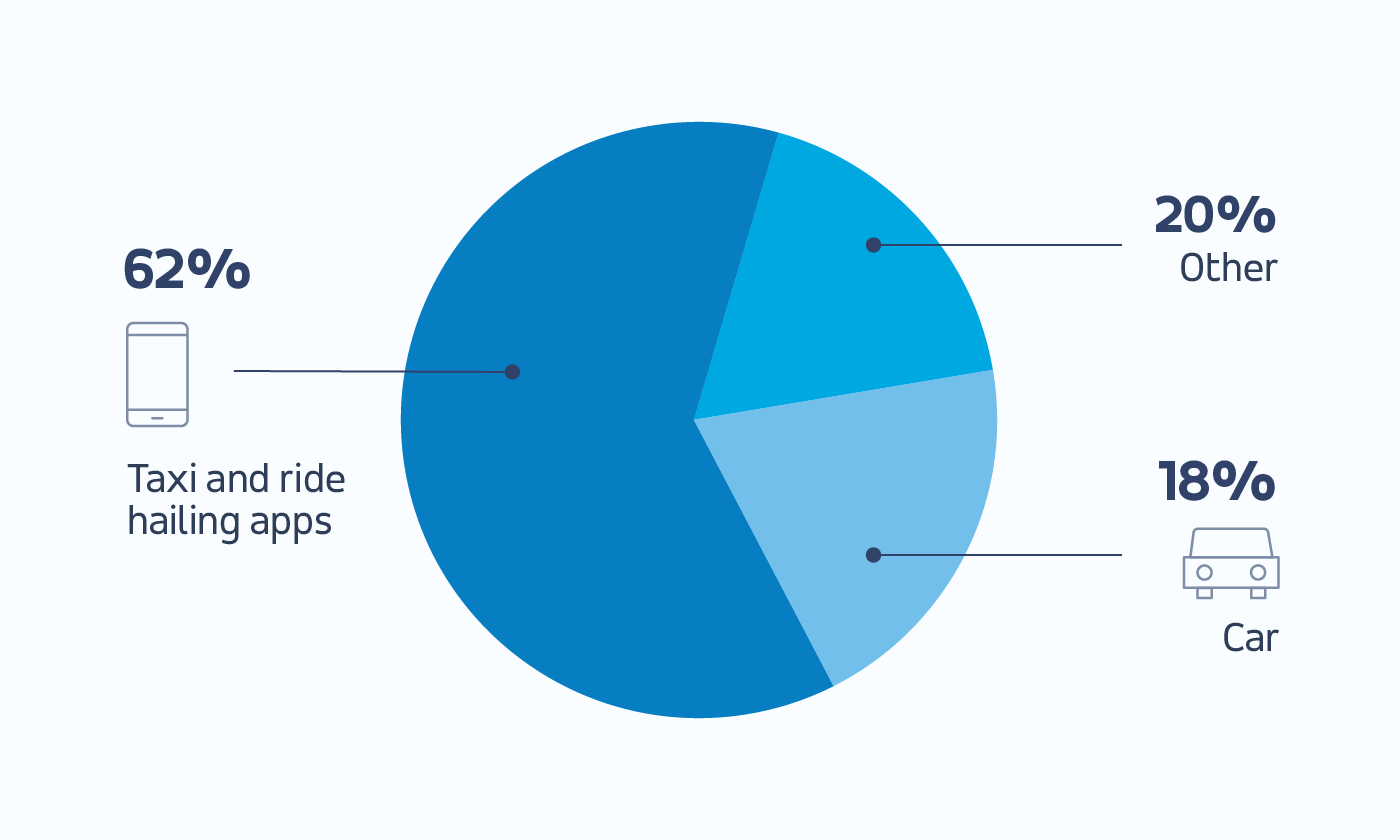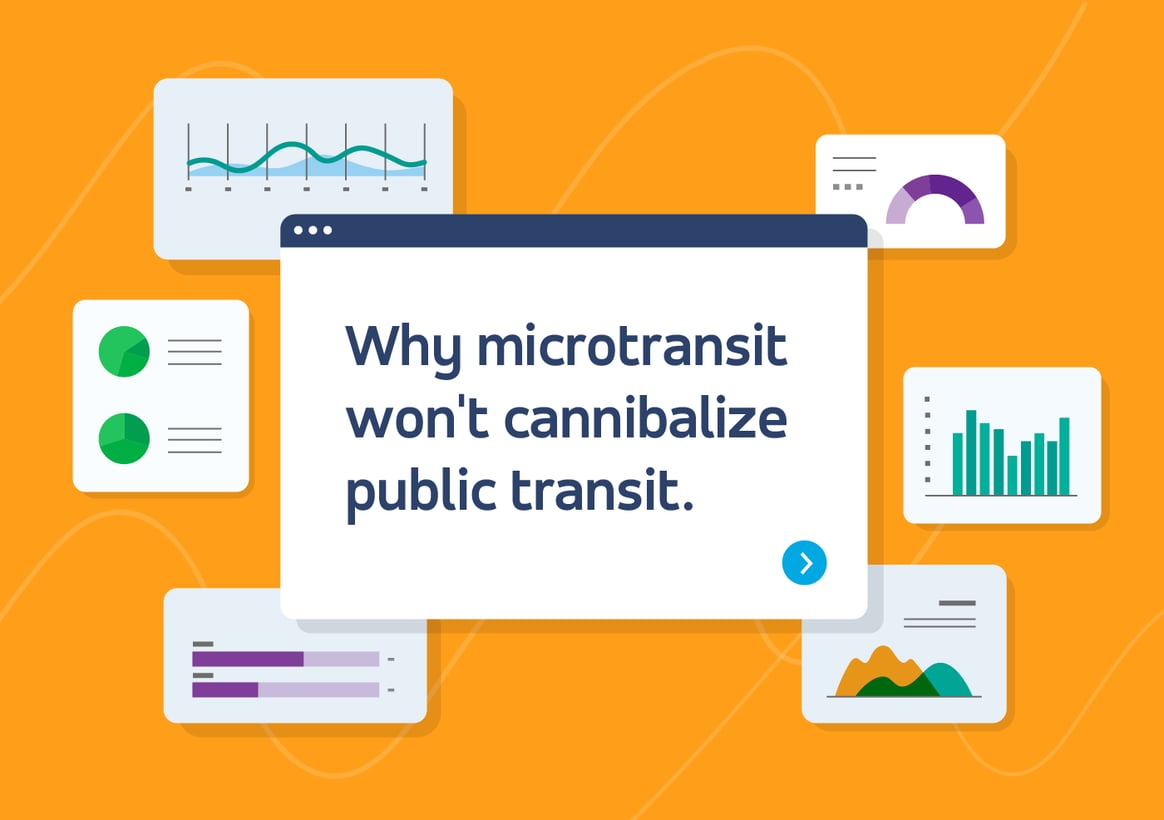Some of microtransit’s biggest critics like to argue that it’s “clearly not the large-scale substitute for bus service that much media coverage makes it out to be.” The thing is, we agree.
In order to achieve transit equity, drastically reduce carbon emissions, and keep cities of all sizes running efficiently, microtransit must complement and adapt to busy buses and trains — modes of transportation that have been tried and tested around the world. And data shows that shared, on-demand services accomplish these goals, by drawing people away from private vehicles (not from existing public transit) even where the two options overlap.
Well, you can’t replace what was never there.
Two of on-demand transit’s most promising applications actually help fixed-route networks (i.e. buses and train lines) succeed:
- Providing a first-and-last mile solution for those needing to get to and from mass transit hubs.
- Offering shared transportation in transit deserts.
In the Detroit suburbs, the Suburban Mobility Authority for Regional Tranasportation (SMART) faced a challenge. Though they offered an extensive bus network, only 2% of people living in the agency's coverage area actually took public transport to work — even though 11% of residents are car-free. Robert Cramer, the deputy general manager of SMART, began looking for new ways to supplement the network and make it work for the people in the region. "You can walk half a mile pretty comfortably to get to some transit stops, but if you need to go farther than that, it no longer becomes convenient for you to take FAST [suburban buses]," he explained.
Working with Via, SMART set out to close the first- and last-mile gap by introducing a microtransit service called SMART Flex. Operating in five discrete service zones clustered around transit hubs and points of interest, SMART Flex encourages transit use by augmenting the existing bus services to offer end-to-end, multimodal journeys for riders. Plotting pickups and drop-offs on the same map as fixed-route bus lines, we can see that on-demand trips cluster at end-points of bus lines, but also extend their reach into the surrounding community.
Click and drag the centerline in the slider below to see how fixed routes and on-demand services complement one another.
In Sydney, Australia’s western suburbs, a partnership between Transport for New South Wales and Busways generated Cooee Busways, an on-demand shared service connecting residents of The Ponds, Schofields and Kellyville Ridge to a number of surrounding Sydney Metro stations.
Before launching, Cooee Busways conducted commuter surveys in 2017 and 2018, which revealed that a whopping 83% of commuters arrived at the Schofields station by car in trips that were overwhelmingly single-purpose, with no other destinations beyond the Metro station. In fact, before the on-demand service even launched, 32% of those surveyed said they would replace their car use if a microtransit service became available and 49% said they primarily owned a vehicle for the purpose of traveling to the station. And now? According to a 2020 analysis by Busways, after only nine months of service, 34% of people holding onto private vehicles for these first-and-last mile trips alone have either already sold or are considering selling their car.
Meeting SOV and TNC riders where they are.
Even where on-demand and legacy mass transportation services coexist, data shows that dynamic transit isn’t poaching passengers from efficient fixed routes and putting them in smaller, on-demand vehicles. On the contrary, on-demand attracts a brand-new kind of rider, one who may not have previously considered taking a bus or train — thereby increasing ridership for a city’s entire mass transit network.
Just look at Goiânia, Brazil. CityBus 2.0 offers on-demand rides to-and-from anywhere in the city (not just to transit hubs or within transit deserts), but the service still isn’t detracting from Goiânia’s robust bus network. Instead, according to a survey conducted by the National University of Brasilia in June 2019, 80% of CityBus 2.0 riders come from SOVs, including taxis and ridehail apps (62%) and personal vehicles (18%).
 Then, there’s Tel Aviv’s popular bubble service. The brainchild of Israel’s Ministry of Finance and Ministry of Transportation, bubble grew out of a microtransit pilot program, with a goal of reducing traffic congestion by expanding public transit. And it has.
Then, there’s Tel Aviv’s popular bubble service. The brainchild of Israel’s Ministry of Finance and Ministry of Transportation, bubble grew out of a microtransit pilot program, with a goal of reducing traffic congestion by expanding public transit. And it has.
In fact, our rider survey from December of 2019 found that 73% of bubble riders who own a private car have used the service instead of their own vehicle at least once, and 20% of all bubble riders reduced private rides consistently (by more than 5 rides) because of the new on-demand service. For those who own a car, that second number jumps to nearly 32%.
Reputation is everything, right?
Ridership metrics aside, passengers have to actually enjoy the service in order for it to succeed. For public transportation leaders, passenger satisfaction can be just as crucial a metric as farebox recovery ratios. An oft-overlooked benefit of integrating microtransit into a public transportation system is the way in which these new services can improve residents’ overall perception of their city’s public transit network and those who run it. Riders using West Sacramento On-Demand in California, which happens to be one of the longest-running services of its kind, report 77% improved satisfaction with the city’s transportation due to this offering. The takeaway? Whether a massive metropolis, tiny suburb, or anywhere in between: TransitTech works by attracting net-new riders to public transportation. If you want to see how it could transform your community, we’d love to show you.
This article is a part of our Clarifying the Counterintuitive series, where we use real data from Via’s existing partnerships to prove why the seemingly obvious path forward might not always equate to a successful service model.




